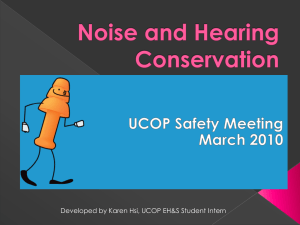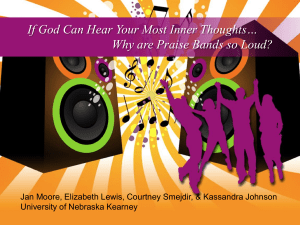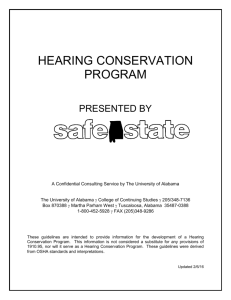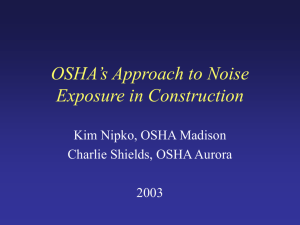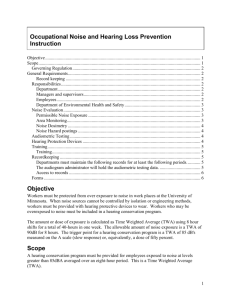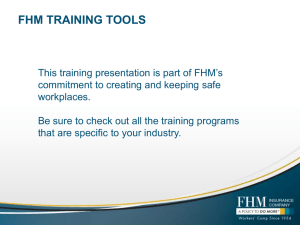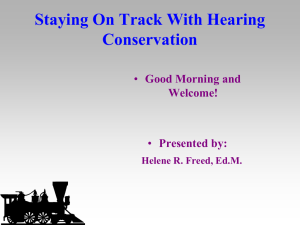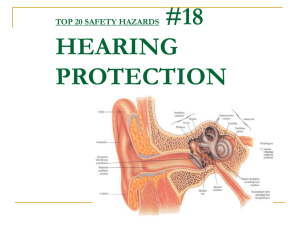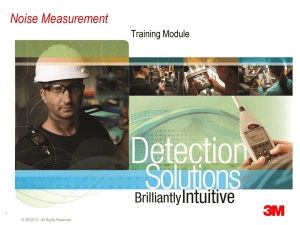Hearing conservation
advertisement
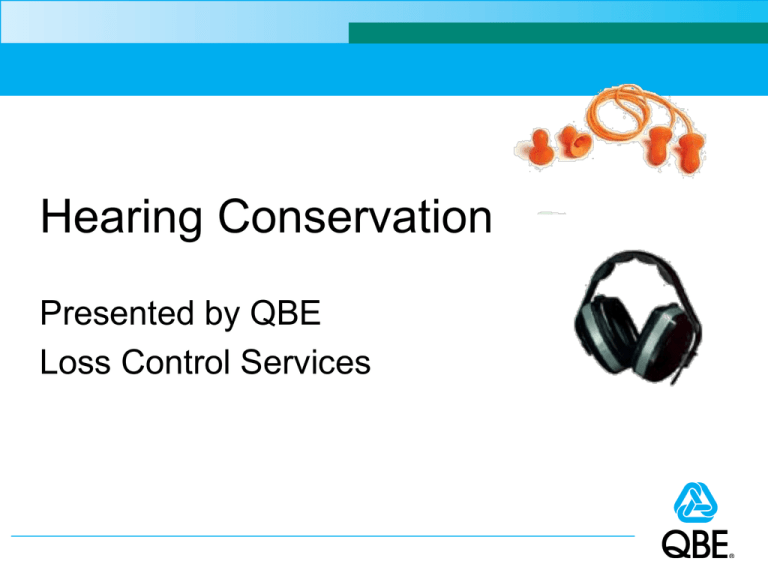
Hearing Conservation Presented by QBE Loss Control Services External Ear • Pinna- Cartilaginous sound wave collector • External Auditory Canal- Leads to ear drum Middle Ear • Eardrum • Ossicular Chain- 3 bones that transmit sound • Oval and Round Windows- membranes separating middle & inner ear • Eustachian Tube- connected to throat equalizes air pressure in out and inner ear Inner Ear • Vestibular System- fluid filled canals • Cochlea- tubular structure filled with fluid and lined with hair cells and nerve endings Sound • Changes in air pressure • Weakest sound heard is a few millionths of a lb/in2 • Pain threshold 10 million times higher Decibels • dB- Logarithm of the ratio of a sound pressure level to a reference pressure level • dB = 20 log P/P0 P0 is 20µPA (micopascals) at 1000 Hz (0 dB) • Increase of 3 dB doubles sound energy • dBA- Decibels using “A” scale weighting which reflects how the ear responds to speech frequencies Sound Levels Pressure Pa 100,000 200 6.3 2 0.2 0.02 0.006 0.0002 0.00006 0.00002 dBA Level Source 194 140 110 100 80 60 50 20 10 0 Rocket Pain Threshold Punch Press Passing Truck Noisy Office Normal Speech Private Office Whisper Good Hearing Excellent Hearing Sound Frequency • Frequency- number of times per second air molecules are displaced by sound wave • Hertz (Hz)- cycles per second • Human audible range20- 20,000 Hz • Speech frequency 500- 2,000 Hz Noise • • • • Sound that bears no information Unwanted by listener Continual- constant level and frequency Impact- sharp outbursts less than 0.5 seconds in duration • Intermittent- Wide frequency range several times per day Noise Effects • • • • • Masks wanted sounds Interferes with speech Causes auditory fatigue Damages hearing Annoyance/stress Non-Noise Induced Impairments • • • • • • • Physical blockage Traumatic damage Disease- infections, tumors, degenerative Heredity damage Drugs- streptomycin, quinine Presbycusis- loss due to aging Tinnitus- head noises Types of Hearing Loss • Conductive- external and middle ear mechanical • Sensorineural- inner ear- nerves and hair cells • Mixed- conductive and sensorineural Effects of Noise • Temporary Threshold Shift • Permanent Threshold Shift Threshold Shift Variables • • • • • • dBA level Frequency Duration of exposure Number and length of rest periods Type of sound- continuous or impact Individual differences Purpose of Audiometric Testing • Test hearing acuity before exposure to noise (baseline) • Annually check hearing acuity against baseline • Check effectiveness of Hearing Conservation Program • Record significant threshold shifts Audiometric Testing • Measure hearing ability at 500, 1000, 2000, 3000, 4000 and 6000 Hz • Standard Threshold Shift- average change in hearing threshold greater than 10 dB at 2000, 3000 and 4000 Hz in either ear Audiogram Noise-Induced Hearing Loss • Higher frequency loss usually first • Permanent damage to cochlea • Insidious- gradual with no pain effect OSHA Noise Standard • OSHA Action Level- 85 dBA average noise level for an eight hour shift or 50% dose • OSHA Permissible Exposure Limit- 90 dBA average noise level for an eight hour shift or 100% dose Noise Monitoring Noise Dose • A measure of noise as a percentage of the permissible limit. • Dose=100 C1+ C2+ C3+... Cn T1 T2 T3 Tn Where Cn is the duration of exposure to a noise level and Tn is the allowable time for exposure to that noise level. (See Tables in OSHA Noise Standard). Other Shift Lengths Shift Length 50% Dose 100% Dose 14 hr 81.0 86.0 12 hr 82.1 87.1 11 hr 82.7 87.7 10 hr 83.4 88.4 9 hr 84.2 89.2 8 hr 85 90 7 hr 86 91 6 hr 87.1 92.1 Action Level Exceeded Implement Hearing Conservation Program • Noise monitoring • Provide hearing protectors • Audiometric testing • Training • Recordkeeping Permissible Exposure Level Exceeded • Implement Hearing Conservation Program • Use engineering and administrative controls to reduce noise levels • Require use of hearing protectors Choosing Hearing Protection • • • • • Ease of use Fit and comfort Hygienic considerations Retainability within ear canal or over ears Heat/cold/moisture Noise Reduction Rating (NRR) • EPA required noise attenuation factor for all hearing protection devices • Maximum noise attenuation of hearing protectors about 35 dBA • Optimal attenuation under laboratory conditions OSHA NRR Determination • Subtract 7 dB from NRR • Take %50 for a safety factor Example: 100 dBA noise exposure NRR for ear Muff= 19 dBA 1. 19 dBA - 7 dBA = 12 dBA 2. 12 dBA x 0.50 = 6 dBA 100 dBA- 6 dBA = 94 dBA. This is above 90 dBA limit so pick more protective protection. Ear Plugs • Formable • Custom-molded • Must fit tightly in ear canal • Hands must be clean • Must be checked and readjusted Ear Muffs • Must seal around ear • Hair must be pushed aside • Glasses may interfere • Use with plugs if over 105 dBA Use of Protectors • Inspect before use • Worn, loose, stiff or deformed protectors should be discarded • Do not use soiled plugs • Make sure fit is snug • Wash and clean frequently according to manufacturer’s requirements • Wash hands before inserting plugs • Don’t use “homemade” protectors Employee Training • Effects of noise on hearing • Company Hearing Protection Program and policies • Specific noise hazards in the workplace • Purpose of hearing protectors • Proper use of hearing protectors • Audiometric testing • Individual employee responsibilities Noise Controls • Engineering controls • Administrative controls Engineering Controls • • • • • • • • • • • • Enclosures Control booths Shields Sound absorbing materials and coatings Reduce vibrations Change noise frequency Reduce speeds Reduce air pressures Install mufflers on air devices Increase distances Provide proper maintenance of equipment Reduce part dropping distances Noise Controls Administrative Controls • • • • • Change way work is performed Reduce number of workers in noisy areas Minimize duration of exposure Rotate between noisy and quiet areas Provide quiet lunch/break areas
